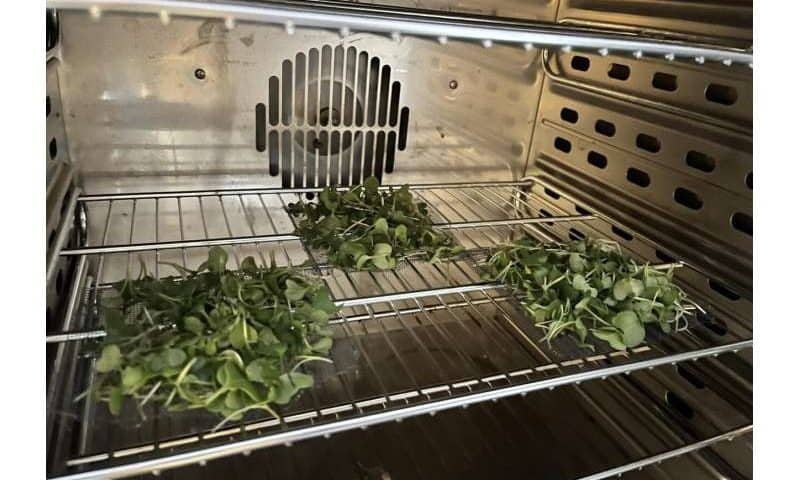Cruciferous vegetables like radish, broccoli and kale offer significant health benefits, especially when they are consumed as microgreens, or as young seedlings harvested early. The little plants contain nutrients such as vitamins; minerals; bioactive antioxidants, like polyphenols; and glucosinolates, which have cancer-fighting potential.
But microgreens are highly perishable and lose nutritional value quickly. In an effort to boost the impact and accessibility of microgreens, a team of researchers at Penn State conducted a study of how hot air drying—a cheap and relatively easy preservation technique—affects the availability of key nutrients and plant compounds that benefit health.
“Microgreens increasingly are popular due to their high concentrations of health-promoting compounds, but their benefits have been limited because they’re highly perishable, lasting only one to two days at room temperature and seven to 14 days with refrigeration,” said team leader Joshua Lambert, professor of food science in the College of Agricultural Sciences, senior author on the study.
“That limits their use, increases costs, and leads to food waste—especially in places without good refrigeration. So, there’s a clear need for preservation methods that keep nutrients intact.”
In findings published in the Journal of Food Science, the researchers reported that radish microgreens, no matter at what temperature they were dried, retained a significant portion of nutrients.
From their drying experiments, the team specifically found that radish microgreens retained 91% of their total phenolic content—antioxidants—after drying at 113°F (F) and 79% after drying at 149 F. Those dried at 203 F retained 100%. Glucoraphenin—a specific glucosinolate with potential anti-cancer properties—was stable after drying at 113 F and 149 F and was retained at 78% after drying at 203 F. Vitamins B1 and B9 were stable at all drying temperatures. Vitamin B2, B3 and C were retained by up to 65%, 64% and 37% respectively with heat exposure.
Using simulated digestion—a laboratory process that recreates the digestive environment of the human gastrointestinal tract to study how food and other substances are broken down and nutrients are absorbed—the researchers also measured the effects of drying methods on bioaccessibility, or how well nutrients can be absorbed by the body after digestion. They found that total phenolic content and vitamins B1, B3, B9 and C had bioaccessibility ranging from 13% to 68%, with no major differences across the drying methods.
Vitamin B2 was more bioaccessible after being dried at 149°F than at other temperatures. Glucoraphenin and anthocyanins—polyphenols that can also act as antioxidants, offering potential health benefits such as supporting cardiovascular and immune health—could not be detected after simulated digestion, meaning they broke down or became unmeasurable, according to Lambert.
Metabolomic analysis—the comprehensive study of small molecules, or metabolites, in cells and tissues—showed that different drying methods led to different overall chemical profiles, noted study first author, Marjorie Jauregui, a pilot plant research technologist at Penn State. Glucosinolates and flavonoids—a class of plant pigments that provide various health benefits—were major contributors to these differences, she explained.
“Hot air drying, even at higher temperatures, can be an effective way to preserve nutrients in radish microgreens, especially for making powders that can be used in food products,” Jauregui said. “While some nutrients are lost, others remain stable and, overall, hot air drying is a practical and promising postharvest method.”
As microgreens are increasingly promoted for healthy eating, understanding how to preserve their nutrients without expensive equipment is essential, Lambert noted, adding that results from this study could help in making nutrient-dense microgreen powders more accessible and sustainable, especially for areas lacking refrigeration or advanced drying technology.
“Freeze-dried microgreens require expensive, specialized equipment to produce,” he said. “Hot air drying is more practical, especially in low-resource areas, but we need to fully understand how different drying temperatures affect key nutrients and phytochemicals—plant compounds that provide health benefits. These results are more than a good start.”

